#lexicon in fashion
Text
some more met gala designs of mine

Whenever I think of positive things from America my mind goes to our conservation of national parks, this dress is a direct inspiration of The Oxbow.

This one is for *gag* Karl Lagerfelds gala, I noticed he used a lot of scoop necks and tiered skirts so I leaned into the Chanel wedding dress look along with a hat, gloves, and pearls. Karl hated pink so I used pink

And now we have gilded glamour, I was inspired by the massive masquerade balls thrown at the time. I have a pigeon breast corset, a narrow skirt, and the peacock overskirt inspired by bustles.
#met gala#in America: a lexicon of fashion#the gilded age#gilded glamour#karl lagerfeld#chanel#the oxbow#thomas cole
17 notes
·
View notes
Text



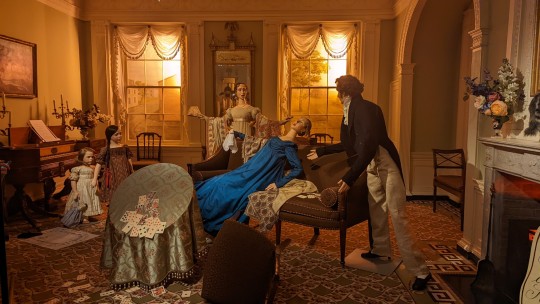
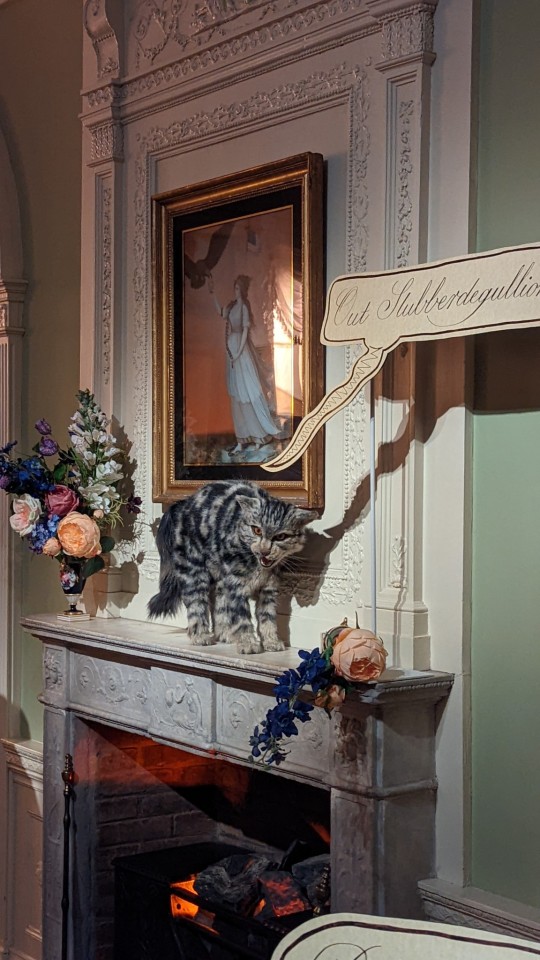
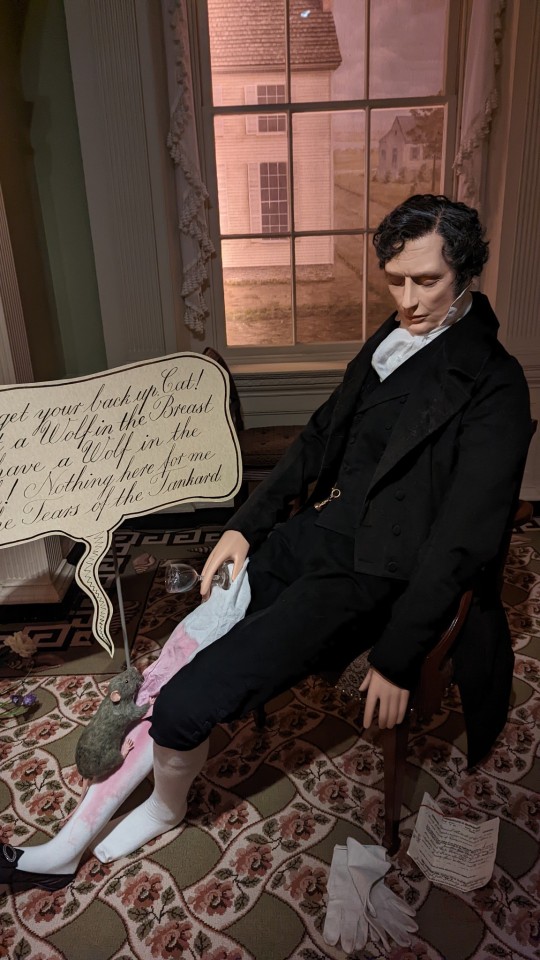


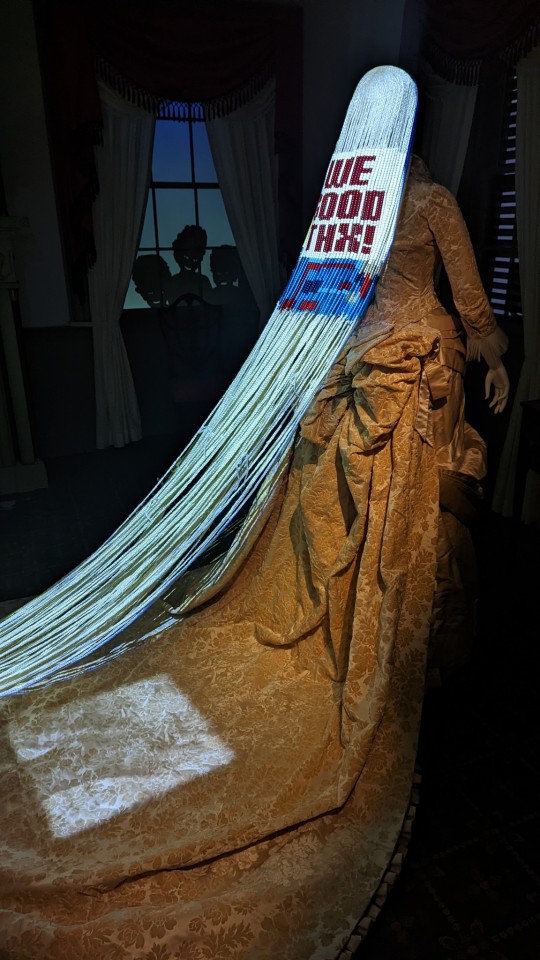
In America: A Lexicon of Fashion, at The Costume Institute at The Metropolitan Museum of Art. Photos: Art Ruby
71 notes
·
View notes
Text
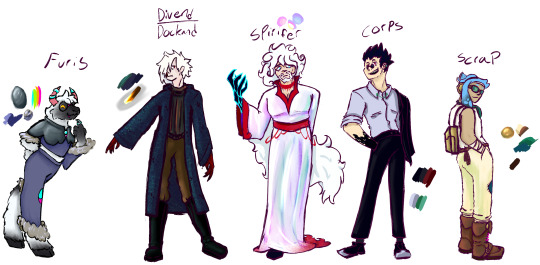
Copperstacks FASHION! feat. some guys from @100nebulas and @caffeinova.
Ramble under the cut!
Common Materials for use in clothing are goat wool, byssus (Mussel silk, p common here), barkcloth, burlap, Fish Leather, Whale/Fish bone, Algal cloth, and furs. Brass, Bronze, Tin and Copper are the most common metals in the area, with most mechanical things being made of Brass or Bronze. Iron and steel are pretty uncommon. Gold is associated with the Church of Pyra, so it's value is a bit artificially inflated. Materials like Cotton, Insect Silks, Linen, velvet, and non-fish leather are more expensive due to being imported, and are more common in rich people fashions.
NOW onto the actual fashions here-
Eclipsed/Furis subculture originates from Eclipsed (werefolk) fashion and culture in Braima, with clothing often made of comfortable, flexible materials and designed to accommodate full or partial shifts into animal form without the need to change, and without the risk of damaging the cloth. They're usually made with goats wool, softened leathers, and "furcloth", a textile made by eclipsed from shed/shaved fur! Furis clothing is usually Asymmetrical, with a "silvery" main fabric and much brighter accessories and accents. Claw, fang, and horn caps/rings are all pretty common too! Non-eclipsed partaking in the fashion are typically dubbed "Furis" or, well. Furries! It's pretty widely embraced, with fake tails, fangs, and claws p much just as available as the jewelry designed for eclipsed! When prints/Symbols are involved, You'll find a lot depicting the two moons, Fangs, or paw prints/animal tracks! For some folks, faux-bite mark designs or embroidery are also involved, though some think its a bit in poor taste.
Divend/Dockends! The names are both slang for Dive hands and Dock Hands! Divehands is the nickname for folks who work in the tide pools, especially farming silk mussels. Dock hands is just the general term for those who work at the docks, usually loading or unloading stuff from boats. People who like the aesthetic for non-work reasons are effectively like. Lighthouse aesthetic enjoyers? y'know the type. usually they're marked by Oilskin boots and raincoats, Fish leather waterproofed through whale oil. The coats are usually Blue/Green, usually bright when first made, and darkening with age. Pants are usually canvas or similarly thick and durable, and tops are usually either like, button-ups, or in colder weather, wool sweaters. Wool hats and gloves are also common.
Spirifers! They're goth. Spirifers are Braima's goths. Literally the whole intent with spirifer fashion is to look like a Ghost. Clothing is usually wispy or has some kind of "flow" to it, with a faint iridescence and Monochromatic clothing (usually white-gray-black) broken up by bright red accents. There's a variant of spirifers that's a bit spikier, with a tendency to Darker colors and Blue/Purple accents rather than Red, that borrows some points from Scrap aesthetic. Alexi's "villain fit" is partially where it originated, though there'd always been a bit of an underground scene in the "aesthetics of those dubbed villains", made a bit more prominent when Alexi had his "Magical girl anime antagonist" moment. (Image for reference)
Then there's the "Corps", Pronounced "Corpse" and short for Corporate, Corps fashion is typical business wear, Dress shirts, black pants, suits and ties, etc. With... an edge. For those "in the know", Corps fashion is actually more than just business casual- It's a signifier that you support, or are a member of, the Mafia. Black or red tops for those who get their hands dirty, white for those too high rank to do so. Jewelry that seems a bit out of place- piercings, symbol heavy rings, etc. Clip on ties, tie alternatives or a lack of a tie altogether to avoid strangulation, holsters hidden on garters or under sleeves, iron toed shoes, tattoos- All signifiers that someone is a Bit More than just a businessman. Tarnished copper that's been waxed/lacquered in order to preserve the green tones is also Very common among Corps jewelry.
Scraps are punks. they're punks who sometimes build their own computers and bikes out of industrial scrap. A lot of scrap fashion originates with Pirates! Anti-government sentiment.Pants made from sailcloth, steel toed leather boots, Woven cord belts, Poet shirts with the sleeves off and leather vests, usually wearing whatever contraptions they've built themselves on their belt or arm. Many of them carry swords/Knives hidden in some way on their person- This is illegal, they don't care.
There's like, a subgroup of Scraps who specifically are against the church of Pyra, and they incorporate a lot more Shark imagery, Sharp teeth, Electricity, Rainbow Neon and brass scale-mail in a nod to Uxsoi, a god of like, storms and madness. Where scraps are punk, these guys are like... EDM/Rave aesthetics paired with like, Satanists? Still punk, but a very different flavor! more occult.
DIY tshirts and stuff is big in scrap culture overall.
honestly though its for most folks, its basically just modern day fits, tshirts, pants, dress shirts, etc etc. The fashion subcultures are just a bit different.
#put it on the atomic freezer#art#copper city#copperstacks#worldbuilding#fashion#ralsei#sabi#lumine#greed fmab#vox#lexicon#i think thats everyone!
5 notes
·
View notes
Text
Things googled today in the midst of writing:
those islands with the black hexagonal rocks (Giant's Causeway)
when were turtlenecks invented
origin of 'turtleneck' etymologically
what do you call a medieval turtleneck (this has nothing to do with the book)
Followed by a half hour maundering on the required verisimilitude of fantasy, followed by looking up what literally anyone else in the world calls a turtleneck. I decided to use 'polo neck,' because the term is plenty early for the faux-period and resemblance of this entirely fictional world.
There is no reason I shouldn't have just used turtleneck, by the way, and perhaps a future editor will remind me of this. But now I've learned they call them skivvys in some places!
#writeblr#ok but i really do want a big lexicon of fashion terminology#with etymological sources#it is my biggest source of ???#all in a summer's month
4 notes
·
View notes
Photo


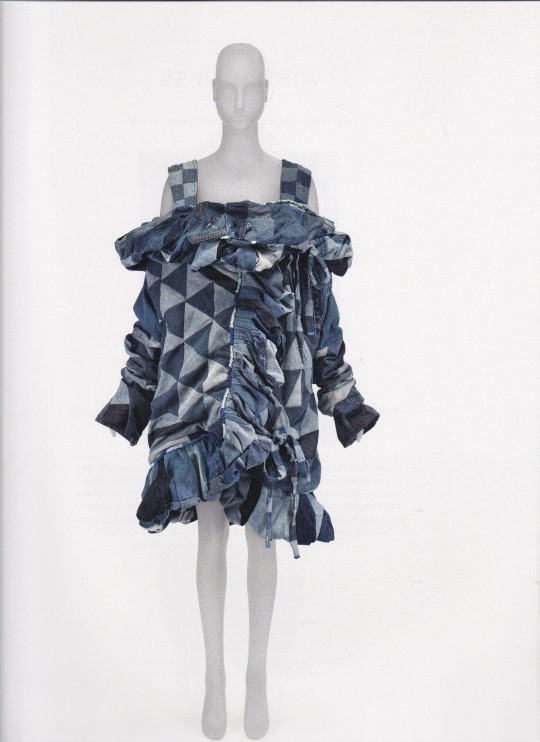




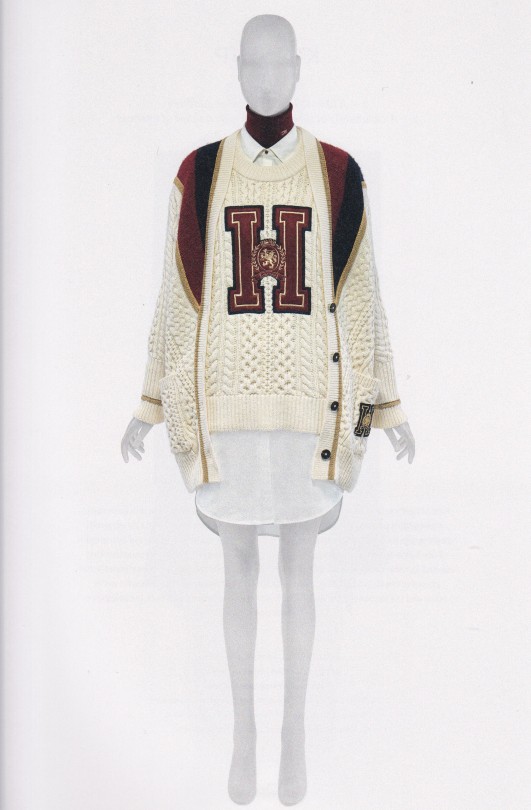
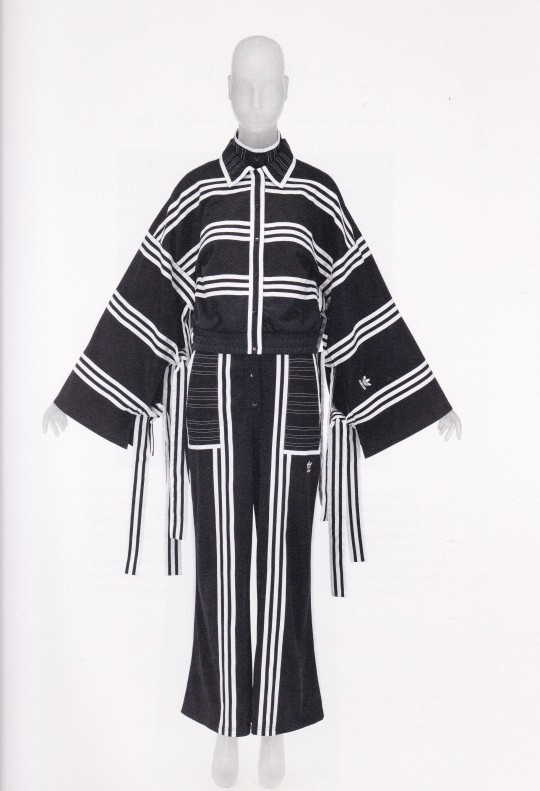

In America
A Lexicon of Fashion
Andrew Bolton and Amanda Garfinkel with Jessica Regan and Stephanie Kramer Photographs by Amma-Marie Kellen
The Metropolitan Museum of Art, New York 2022, 257 pages, Hardcover, 24.77 x 31.12 cm, ISBN 978-1588397348
euro 53,00
email if you want to buy [email protected]
A new glossary of American fashion explores the expressive qualities of works by pioneering designers, who established the nation’s style, and the up-and-coming designers shaping its future.
In America: A Lexicon of Fashion presents a modern vocabulary of American dress that emphasizes emotions while not discounting the simple, practical, and egalitarian character that has traditionally separated American ready-to-wear from European haute couture. Stunning new photography showcases over 100 garments from the 1940s to the present that offer a timely new perspective on the diverse and multifaceted nature of American fashion.
The catalogue features works that display qualities such as belonging, comfort, desire, exuberance, fellowship, joy, nostalgia, optimism, reverence, spontaneity, strength, and sweetness by well-known designers and emerging creatives, including:
Gilbert #Adrian, Geoffrey Beene, Thom Browne, Bonnie Cashin, Willy Chavarria,
Olivia Cheng, Telfar Clemens, #OscardelaRenta, Colm Dillane, #Perry Ellis, Tremaine Emory, #TomFord, #RudiGernreich, #Halston, Elizabeth Hawes, #CarolinaHerrera, Conner Ives, #CharlesJames, Kerby Jean-Raymond, #DonnaKaran, #CalvinKlein, Michael Kors, #RalphLauren, Vera Maxwell, #ClaireMcCardell,Norman Norell ,Heron Preston, Christopher John Rogers,
Raul Solís, Hillary Taymour, #DianevonFurstenberg, Vera Wang
orders to: [email protected]
twitter: @fashionbooksmi
flickr: fashionbooksmilano
instagram: fashionbooksmilano
tumblr: fashionbooksmilano
03/02/22
#In America#Lexicon of fashion#fashion Exhibition Catalogue#Metropolitan Museum of Art New York 2022#american fashion#fashion books#fashionbooksmilano
3 notes
·
View notes
Text

Fredrik Robertsson wearing a custom design by Iris van Herpen
#“In America: A Lexicon of Fashion”#Jared Leto#Fredrik Robertsson#It's Fredrik Robertsson Not Jared Leto#Iris van Herpen#Fashion#Haute Couture#Art of Haute Couture#Gilded Age#Met Gala theme#2022 Meta Gala
5 notes
·
View notes
Note
i assumed he was there for the met gala
Oh shit, you're right. I literally erased that from my mind because I am not at all excited to see it 😮💨 Hopefully, this year is less disappointing than last year and everyone tries to stay on theme.
3 notes
·
View notes
Text

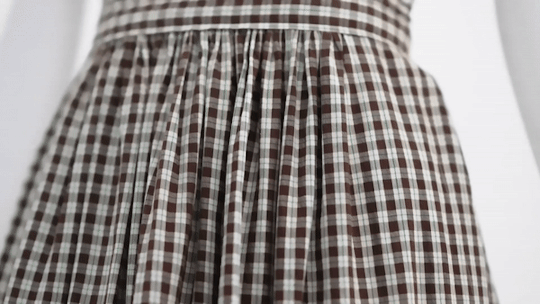
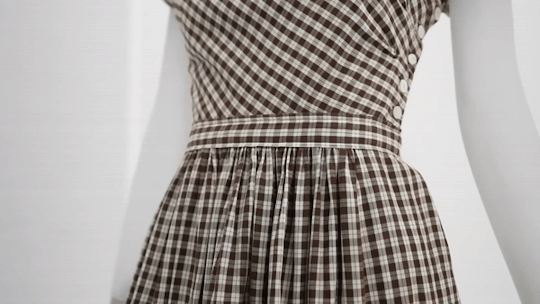

#fashion#In America: A Lexicon of Fashion#design#details#inspiration#style#fashion collection#style inspo#art#dress
1 note
·
View note
Text
So for basically my whole life I'd grown up with and was resigned to accept that the chinese concept of formal/nice clothing of my and the previous generation has been western clothes. So at any awards ceremonies or performances, entertainers would show up mostly in western suits/dresses and maaaaaybe you'll spot the occasional cheongsam if they're going for a Wong Fei Hong vibe. Which, you know, kinda sucks if you have any concept of western cultural imperialism in asia.
So when the hanfu revivalist movement started, I was waiting to see when it would enter the mainstream -- my hope was for fashion designers to integrate traditional/dynastic elements into their work and make it common place enough that I can buy this shit online for ME. Because I WANT.
Though some of the designs can be a bit hit or miss, I am LOVING what various stars and entertainers are wearing out and about now.
Anyway - here's a collection of Xiao Shunyao's modern hanfu inspired/hybridized stage outfits from the last couple years. For his MLC performances, his stylists seem to be borrowing inspiration from his Di Feisheng and possibly other character costume silhouettes.

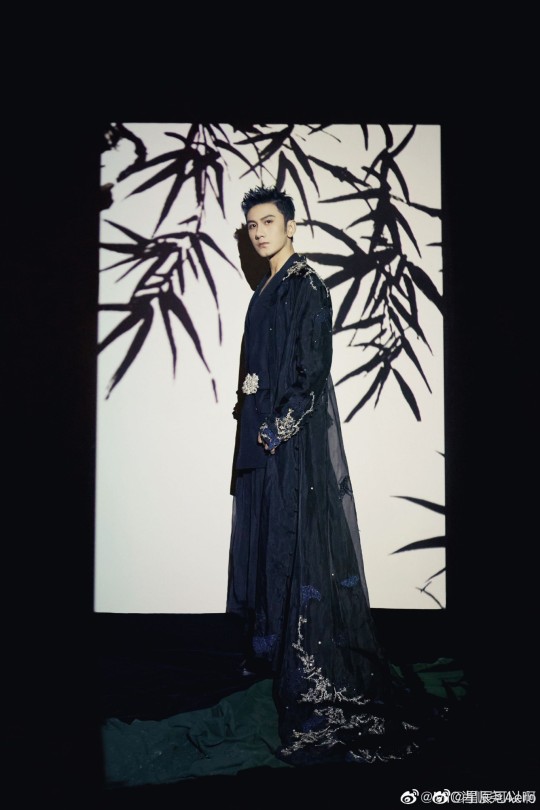
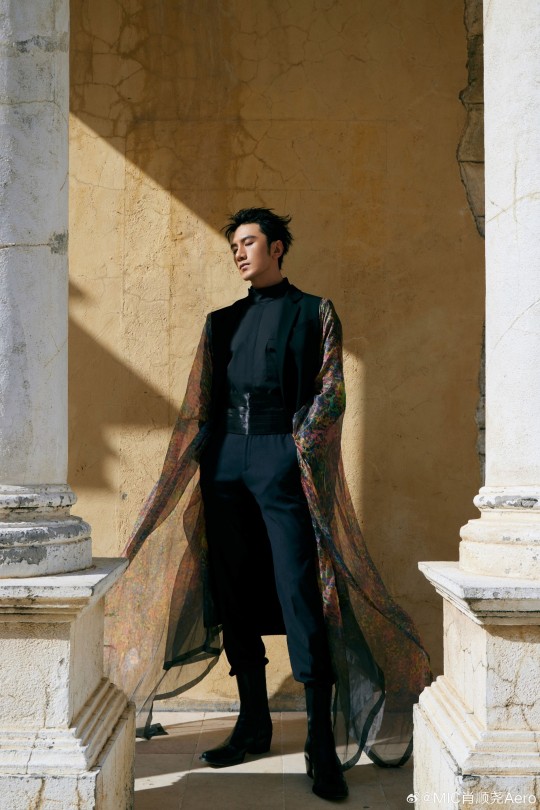
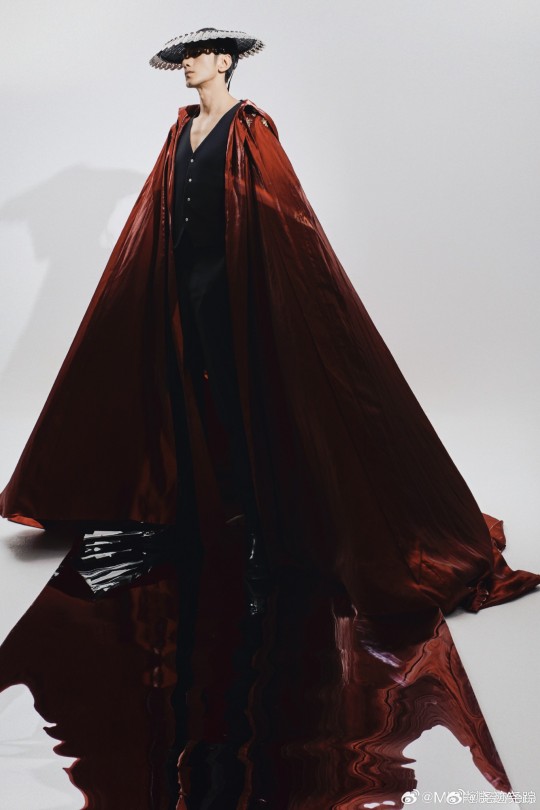

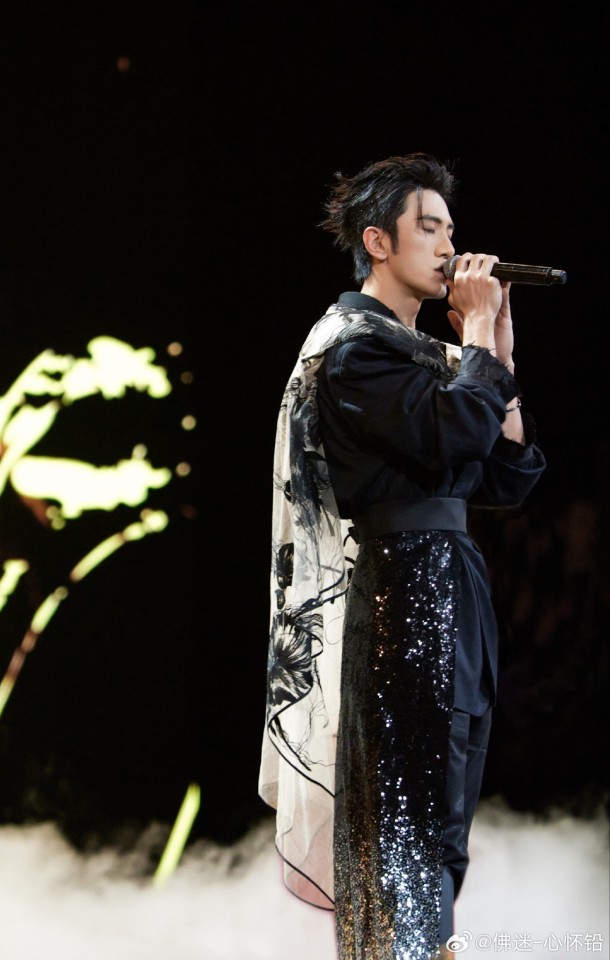


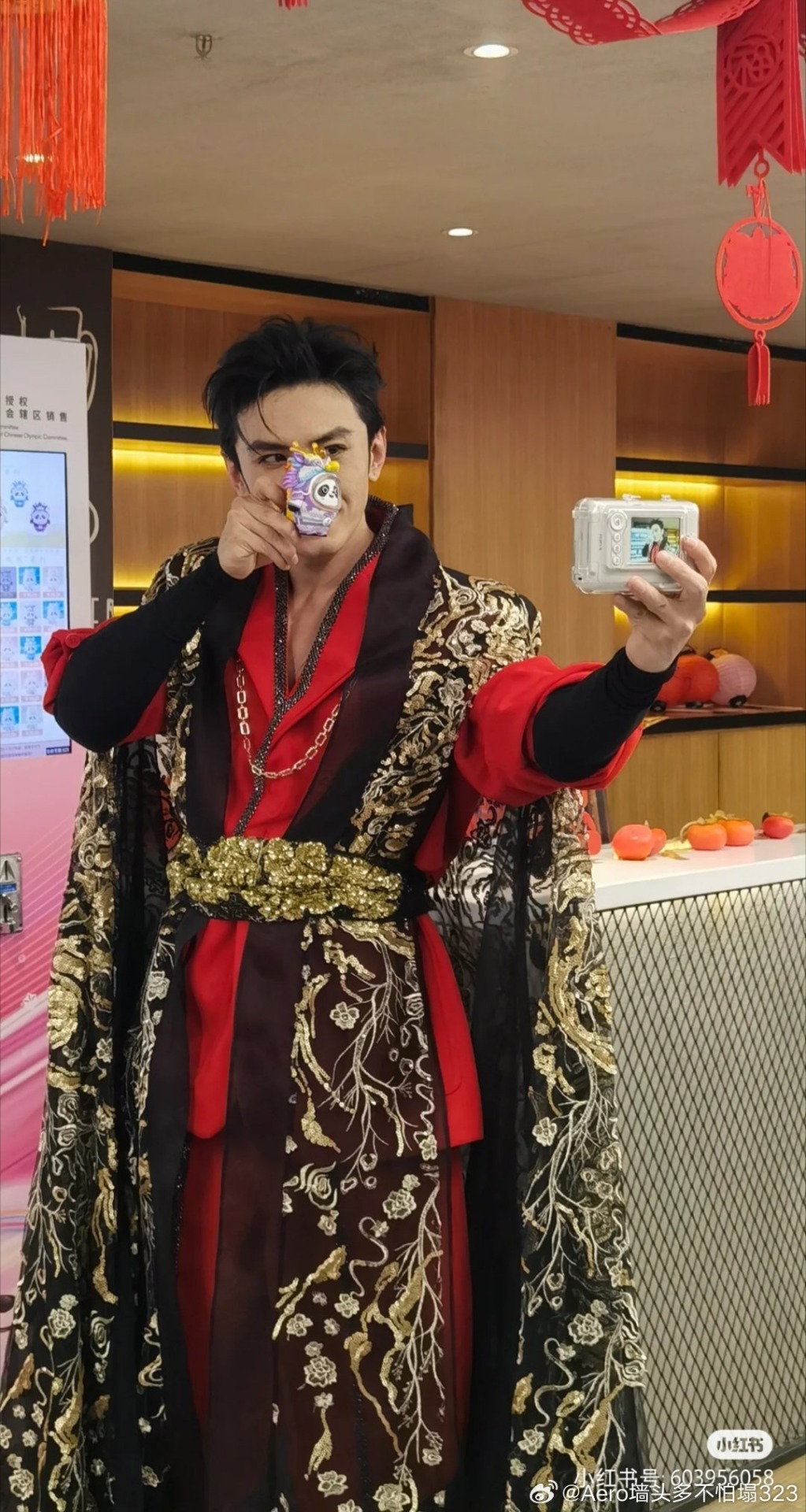
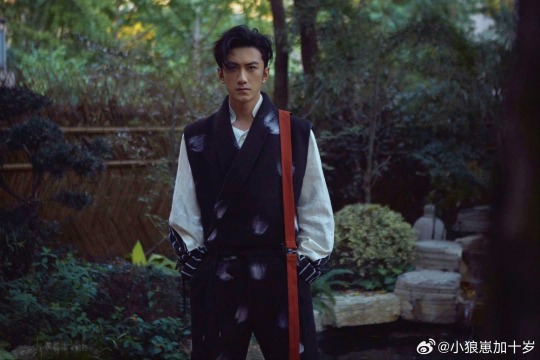
I'd been seeing a few comments about how his outfits play with gender - and some of his outfits do! But I think the interesting thing to discuss is from which standard is he playing with gender? Because from a western perspective, the things he does with his western suit tops, belting on top of the jacket for a tightly cinched waist, and the addition of a trailing skirt = femme. But if you're talking from a hanfu-hybridized pov, that's just a modern take on hanfu and having any of those elements is not inherently femme and would often read masc to me.
So these things aren't necessarily gendered because they exist traditionally in chinese men's clothing or costume designs (ie video games, comics, historical fiction illustrations and film, etc, so therefore in the modern lexicon of masculine/acceptable for men):
presence or lack of a skirt
silky, velvety, gauzy or sparkly material choice, esp in formal or stage clothing
short or long length of skirt
embroidery
flowers/floral/bird designs
folding fans
certain styles of makeup
beading, gold, tassels, jewels
non-chunky jewelry
headbands
widely flowing silhouettes
What XSY's stylists are doing with some western clothing items are interesting. I'm convinced there have been one or two western jacket tops made of thinner material that they're folding over the front, and belting down instead of buttoning (which then matches with his other outfits that are designed specifically to do this). Then they're adding a skirt, cloak or bracer element to it.
The western portions often bring a military minimalist feel which they balance with a more gauzy material in the skirt or cloak portions.
Things I think are playing with gender:
row 1 - image 1: red di feisheng-inspired outfit
The lace-up girdle is there to match the bracers in both material and style. And it's positioned to be similar to the heavy belt that Di Feisheng wears.
HOWEVER. That style of girdle/corset-like clothing item can't be divorced from the modern idea of sexy leather corsets. So imo, this waist piece on that outfit was a choice. Especially when paired with his allergic-to-collars-higher-than-his-sternum necklines. And if you take into context how masculine yet female coded his character is in the drama, the whole look evokes that.
row 2, image 1: black western suit with belt on top, hat, cloak, black boots and not-visible but also a black tassel fringe skirt
Hat and cloak moves the intention of the outfit from western toward a more Asian slant, because alone, it looks like a western black suit with western heeled boots, cinched waist with a lady's belt (seated photoshoot) and western style tassel skirt.
The suit top consists of a vest and a shrug-like sleeve portion that appears masculine at first glance. But take the shrug and pair it with the tassel skirt (I can't find the red carpet photos but here is a better view of the skirt when seated), and I think you got a look that's both intentionally edging toward the femme in a western sense but also confusing matters by hiding within the parameters of both western and chinese traditional male styling.
row 2 - image 2 : white asymetrical western jacket styled in a front fold-over style, gauze skirt, trailing pearl embellishments
The more traditional leaning version of this is the white outfit in row 3 that he wears to the Hi6 Hello Saturday variety show -- the skirt portion on that outfit is one I'd consider non-gendered.
Row 1, images 2 and 3 are examples of masculine/neutral uses of gauze that plays with flow of form but isn't inherently femme.
This stage outfit is very western-appearing masculine suiting, until you hit the skirt which is giving me long ballerina tie-on skirt with the additional swan/mermaid pearl strings. Imo, another example of deliberately using traditional masculine styling but switching it up with the combination of material choice and make that is feminine.
row 2, image 3: black space military boots, black suiting, black -silver ombre sequin trailing skirt and white gauzy shawl with black floral design
The over all design is going for a masculine military-feel. (think this outfit for shen langhun) But instead of a thicker military cloak, it's replaced with a woman's gauze shawl and a skirt that trails behind him very much like the back of a woman's formal fish-tail gown when he moves around.
If you take into context Wang Herun's outfit is a white-silver sequined dress cut in a way to also give a space-military-queen vibe, imo they both coordinated their outfits to balance out with both femme and masc qualities.
Thoughts? I'm curious what others think about this.
While I wait for the CNY photoshoot for XSY's red and black look, here's him with his stage collaborators with a nice range of skirt lengths, period influences and material choices. The woman in the center is the one with the most military-fighter design out of the bunch. The dudes are all in variations of formal-wear-with-good-kicking-boots (and lots of crotch space).
#xiao shunyao#mysterious lotus casebook cast#my royal ramblings#fashion#chinese fashion#gendered fashion in cultural context
1K notes
·
View notes
Text
BREAKING NEWS.
“two bits” means one quarter. as in 1/4 of a U.S. dollar.
you’re welcome and have a nice day.
#money#english slang#american slang#coins#currency#old fashioned#phrases#two bits#vocabulary#definitions#lexicon
1 note
·
View note
Text

Imaan Hammam wearing VERSACE
– Met Gala (2021) In America: A Lexicon of Fashion
981 notes
·
View notes
Text

Imaan Hammam at The 2021 Met Gala Celebrating In America: A Lexicon Of Fashion

713 notes
·
View notes
Text
I think when people describe dark hallways or all-grey office cubicles as “liminal,” they’re using it as a synonym for creepy, which is not really accurate. What’s being reached for is a sense of dislocation, of being in a place that is not meant for you or is otherwise hostile to you in some way. “Liminal” is limited in its ability to describe those feelings, because the word is typically meant to refer to a place that exists only to get you somewhere else (like an airport, for example, or an interstate highway). “Liminal” isn’t synonymous with “a place of horror,” but I think it’s become that in the tumblr lexicon.
I think a much more robust term for what people are trying to describe is ontological (in)security. Ontological security in geographic scholarship means “a confidence that the world exists as it appears to be.” To give a very basic example, there are handles on doors because the function of a door is to act as a gateway to another space, and the handle is there to open that gateway. You trust that doors with handles are meant to be open and stepped through, and you also trust that door handles will always be placed at a standing person’s waist height - if you’ve ever seen a character try to open a door that leads nowhere in a story, it’s playing with your ontological security. Likewise, you see a flight of stairs and understand implicitly that it exists to facilitate pedestrian traffic to and from a specific place. It’s not a place to have a party with your friends, and you wouldn’t think to go to a stairwell to socialise.
To be ontologically insecure, on the other hand, is to exist in a place that is built for purposes that are not available to you. This is most commonly used in disability scholarship to refer to inaccessible entrances or stairwells - these things exist for able-bodied people only, and the structure of the built environment is now acting as a mechanism to divide people into groups who can use the space and groups who cannot. This is part of the way that ableism essentialises disability, which is then reproduced in the built environment - urban structures are taken as neutral, and if you can’t navigate them effectively, something is wrong with you individually (which of course is not true).
But this idea can be deployed for a variety of contexts - suburbs once built for the wealthy car-driving middle class typically do not have sidewalks in them. And now in many places in North America, suburbs are being inhabited by much poorer families (who are much less likely to own a vehicle), who are being driven out of the city core because now that same wealthy middle class has decided a condo is more fashionable than a detached house. This leaves people to live in places that aren’t built “for them,” to walk in the middle of roads or on lawns because there’s no space for them to walk, forcing them into hostile situations to either be hit by cars or yelled at by neighbours for walking on their grass. These spaces produce ontological insecurity, a sense that you are inhabiting a place that is not meant for you, and because of this you are frequently made less safe as a result.
This is where the critique that cities are structurally ableist, or racist, or misogynistic comes from. Urban environments are usually built by the ruling class, whose interests and aesthetic sensibilities get reproduced in the roads they build and houses they erect, and if you don’t happen to fit the profile of the ruling class (ie most people), some parts of a city are always going to be less safe for you. This is why in extremely spread-out, low density cities (LA for example), public transit is difficult to implement on a structural level (on top of all the political pushback), because these spaces are structured in such a way to be hostile to certain modes of travel or behaviour (eg any mode of transit that isn’t a car). They are built for a specific ideal archetype of person, and if you don’t fit into that, you’re much less safe and much less secure.
So if you want to use this in fantasy settings or horror or whatever, you need to approach the built environment as a historical process the same way that a government or law is. Office spaces are not “liminal,” but they can be sites of horror because their physical structure compels certain modes of social behaviour, and trying to work against that grain can make you feel “out of place” - i.e., ontologically insecure.
#geography#book club#slightly edited the definition#since ontological security means something different in geog than it does in other academic spheres
772 notes
·
View notes
Note
What was your favorite met gala gown?
This is a tough question and my answer is going to be a long one. Mostly because this was the second part of a two-parter exhibition. In America: A Lexicon of Fashion was the exhibit in September last year, and that particular gala seemed very boring. There wasn't a specific theme other than Americana, so it was underwhelming since it encompassed such a broad amount of time. So when they announced that this gala had a 'Gilded Glamour' theme, I was thrilled that they were trying to hone in on a specific time period. Unfortunately, they announced it not even a month ago. The amount of time that goes into planning these looks spans well beyond a month, so while I think the theme was grossly ignored, the theme announcement came way too late for designers and celebrities.

Also, fashion designers are who truly get the invites to the gala. Vogue does invite a handful of celebrities and they get to work with whatever designer they want, but when we see a crowd of celebrities with Moschino or Louis Vuitton or Prabal Gurung...the designers choose what the celebrity wears. So unless you're at a certain level of star power, sometimes you just get to show up and look out of place (I'm looking at you, Michael Kors and LV girls) because the designer gets to choose. With that said, here is my favorite. And some honorable mentions.
Blake Lively is my winner. I loved the homage to the Statue of Liberty and its patina effect. I actually didn't really like it when I first saw her on the carpet...the metallic bow gave me more of an '80s vibe. But after her reveal and the bow unfurled...I loved it. The tiara, the gloves, the designs on the dress. I loved it all and seemed like a love note to New York City. Blake is one of the ones who gets to envision an idea and talk to a designer and make it come to life. She really did have a big hand in designing this with Versace and you can tell by the amount of pride she had when breaking the dress elements down. And bonus points: the Statue of Liberty arrived in 1885, right in the middle of the gilded age time period.
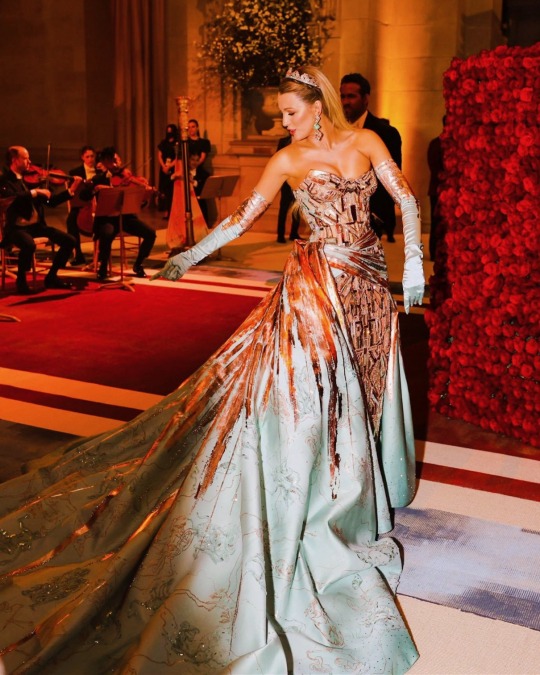

Billie Eilish is my runner up. She took the theme to heart. I love that she asked Gucci to use upcycled materials. I don't have anything else to add because she's the only one who literally went with the theme and I applaud her.
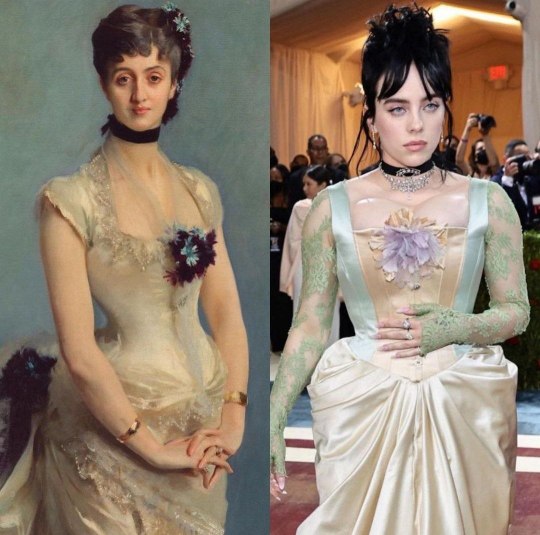
Chloe Grace Moretz in Louis Vuitton. Even though I didn't like the LV girls as a whole, Chloe is the exception for me. I loved the nod to men's fashion in the gilded age and I wished more men actually went this route.


Rosalía in Givenchy. The glasses annoyed me. But I do love the dress. The nod to gigot sleeves are probably what make the look for me.


I also really loved Carey Mulligan's Schiaparelli dress. I think she flew under the radar because while the dress might be safe, I do love the nod to gilded equaling gold and gilded aged fashion. And while I'm surprised at how tame it is, considering Schiaparelli's looks can be way out there, I think it was a lovely mixture of gilded age fashion in a modern look.
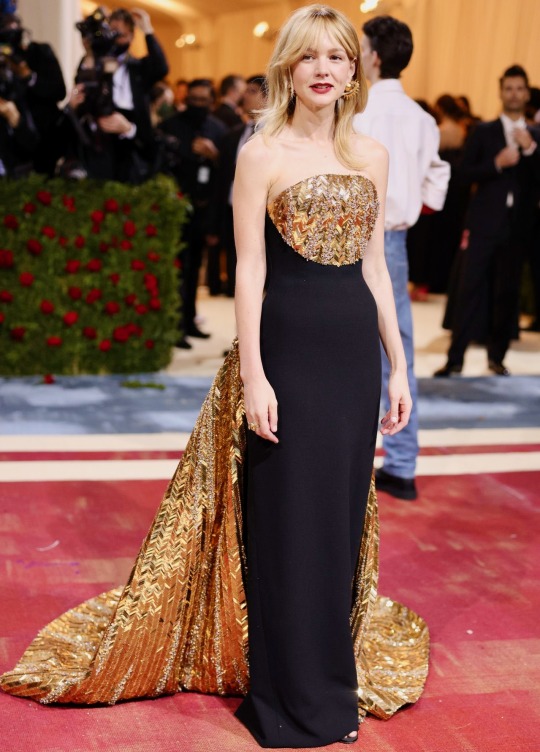
And finally, the Cinderella story of the night: Genesis Suero wearing Lucia Rodriguez. Flawless. The dress fit the theme. And like so many people who stopped reading the theme after the word 'gilded' and just said, GOLD EVERYTHING...Genesis had a 2-for-1. A gorgeous golden gilded age dress.

I had high hopes for this gala and the theme, since historical shows are so popular right now. And I was even willing to overlook people disregarding the era of the theme and thinking it just meant they had to be dripping in gold. But I could not believe the amount of people who thought this theme included the roaring '20s or the golden age of Hollywood. Once again, the best Met Gala by far, was 2018's Heavenly Bodies, and I'm disappointed that more people didn't show up with high neck, bustles, gloves, and lace.
Thanks for asking! Sorry this turned into a novel. I guess I'm very passionate about the Met Gala.
3K notes
·
View notes
Text
Sort of related to the post about people coming in for shipping but something that’s struck me, as actual play fandom has spread, is that there is a certain lack of genre awareness currently - not just surrounding Critical Role, to be honest; it’s a frustration for me for the conversation surrounding Dimension 20 and Worlds Beyond Number for a while as well.
Take fate, for example. The idea of fate, whether it’s as specific as an ancient prophecy, or as broad as the general concept of destiny, is absolutely at the core of so many classic fantasy series that to be vehemently opposed to it within Critical Role is to display profound ignorance of the genre of fantasy. It’s akin to showing up to a sporting event and getting mad that people are running around in athletic gear; it’s like going to an Italian restaurant in the US and screaming in the face of the waiter when they give you bread and olive oil. There is not, per se, a required reading list. You do not need to read nor watch all of Lord of the Rings let alone consider it a formative work; Sam Riegel and Aabria Iyengar sure haven’t. But if you are not familiar with the genre at all, at the very least you do need to come with a certain awareness that you are not familiar with the genre and be open to its conventions. And to be clear: it’s valid to hate the theme of things being fated. But again, that’s like hating they serve bread and olive oil at the Italian restaurant; you should probably simply not go to Italian restaurants.
Another example that is my personal source of irritation is the obsession with radiation as a factor in Burrow’s End. Setting aside my original irritation at just good old-fashioned lack of reading comprehension with the conflation of the poison and the Blue/the Light, the idea that the intelligence was induced by radiation is really…not genre aware. Like, I recognize I’m coming at this with rather more knowledge than average (from a scientific rather than genre-aware perspective no less) but to get back to genre, I take no issue with, say, radiation in comic books. I know the premise of Spider-Man or of Doctor Manhattan’s origins is absolutely ridiculous; but that’s the genre. Radiation in comic books exists to be an easy origin story so we can get to the point of “here’s a guy with powers”. However, in a show that derives its narrative language from Watership Down and Mrs. Frisby and the Rats of Nimh, the idea that the magic and the lightning and the source of intelligence are radiation makes little sense. Another example is the weird response to Skip in Starstruck; the idea of an alien brain parasite like that is so genre-typical to space opera it feels like, again, someone going to an Italian restaurant, pointing at the bread, and saying “WHAT THE FUCK IS THAT? HOW DARE YOU!”
I think my particular frustration with both of the above (and when I talk about Worlds Beyond Number) is that those people ignorant of genre and not letting it wash over them a la Sam will often fall back to the real world (although, unfortunately, not when it comes to radiation) when trying to make sense of the narrative without the signposts, language, and tropes of the genres to which they belong. To understand the subversions or deconstructions that are likely to occur in, for example, the upcoming exploration of the Citadel in Worlds Beyond Number, you need to be open to the idea that it is a complicated place and not simply The Evil Empire That Suvi Will Definitely Leave; if you’re utterly suspicious of everyone and refuse to try to understand why this is a place people enjoy let alone will die for, you can’t actually experience the story. We are going into the Citadel arc; these wizards will be humanized, and if you have closed off your mind to them already you have set yourself up to be miserable.
I do think it’s great that actual play has found an increasingly large audience, but the medium of actual play also carries a certain lexicon and ignorance of it will skew one’s interpretations. My personal bugbear here is of course interpreting bog-standard tanking strategies as either romantic or self-sacrificial in intent, but in general, any resistance to the mere concept of gaining power, the existence of concrete deities, combat, and the placement of plot above romance in D&D are all signs of this ignorance. And again: ignorance is fine! But with all of the above there also often comes this entitlement to a story that is familiar, in blatant disregard for those parameters of genre and medium, and I have to wonder, again, why people mad that a fantasy story is leaning heavily on fantasy story norms, or why D&D has combat, are still showing up to the fantasy D&D story. To return to the Italian restaurant, which is getting a lot of terrible patrons in this metaphor, it feels like a lot of people are showing up to this restaurant because they heard it was good, but then becoming furious it won’t serve them peanut butter and jelly. People who are not familiar should still be welcome, but that lack of familiarity needs to be accompanied by an openness and desire to learn, rather than the entitlement that is so often present.
62 notes
·
View notes
Text
List of Met Galas since 2001
I've gotten a few asks for a list of Met Galas. Technically, the gala has existed since 1948, and been themed since 1973, but I started at 2001 to keep it short (there was no gala in 2000 apparently). If you're interested in every theme that's ever existed, there's a chart on Wikipedia.
Most lists online start somewhere around 2011-2013, since it wasn't covered by the press the same way before then.
2001 Jacqueline Kennedy: The White House Years
Co-chairs: Anna Wintour, Christina and Lindsay Owen-Jones, Annette and Oscar de la Renta, Carolina Herrera Caroline Kennedy and Edwin A. Schlossberg
Sponsor: L'Oreal
2003 Goddess: The Classical Mode
Co-chairs: Anna Wintour, Tom Ford, Nicole Kidman
Sponsor: Gucci
2004 Dangerous Liaisons: Fashion and Furniture in the 18th Century
Co-chairs: Anna Wintour, Renée Zellweger, Lawrence Stroll, Silas Chou, Edgar Bronfman Jr. Jacob Rothschild, Jayne Wrightsman
Sponsor: Asprey
2005 The House of Chanel
Co-chairs: Anna Wintour, Karl Lagerfeld, Nicole Kidman Caroline, Princess of Hanover
Sponsor: Chanel
2006 AngloMania: Tradition and Transgression in British Fashion
Co-chairs: Anna Wintour, Christopher Bailey, Sienna Miller Rose Marie Bravo, The Duke of Devonshire
Sponsor: Burberry
2007 Poiret: King of Fashion
Co-chairs: Anna Wintour, Cate Blanchett, Nicolas Ghesquière François-Henri Pinault
Sponsor: Balenciaga
2008 Superheroes: Fashion and Fantasy
Co-chairs: Anna Wintour, George Clooney, Julia Roberts, Giorgio Armani
Sponsor: Giorgio Armani
2009 The Model As Muse: Embodying Fashion
Co-chairs: Anna Wintour, Kate Moss, Justin Timberlake Marc Jacobs
Sponsor: Marc Jacobs
Ticket Price: $7,500
2010 American Woman: Fashioning a National Identity
Co-chairs: Anna Wintour, Oprah Winfrey, Patrick Robinson
Sponsor: Gap
2011 Alexander McQueen: Savage Beauty
Co-chairs: Anna Wintour, Colin Firth, Stella McCartney François-Henri Pinault and Salma Hayek
Sponsor: Alexander McQueen
2012 Schiaparelli and Prada: Impossible Conversations
Co-chairs: Anna Wintour, Carey Mulligan, Miuccia Prada, Jeff Bezos
Sponsor: Amazon
2013 Punk: Chaos to Couture
Co-chairs: Anna Wintour, Rooney Mara, Lauren Santo Domingo, Riccardo Tisci Beyoncé
Sponsor: Moda Operandi
Ticket Price: $15,000
2014 Charles James: Beyond Fashion
Co-chairs: Aerin Lauder, Anna Wintour, Bradley Cooper, Oscar de la Renta, Sarah Jessica Parker, Lizzie and Jonathan Tisch
Sponsor: AERIN
Ticket Price: $25,000
Theme Announcement: September 4th, 2013
2015 China: Through the Looking Glass
Co-chairs: Anna Wintour, Jennifer Lawrence, Gong Li, Marissa Mayer, Wendi Murdoch, Silas Chou
Sponsor: Yahoo
Ticket Price: $25,000
Theme Announcement: September 11th, 2014
2016 Manus x Machina: Fashion in an Age of Technology
Co-chairs: Anna Wintour, Taylor Swift, Idris Elba, Jonathan Ive Nicolas Ghesquière, Karl Lagerfeld, Miuccia Prada
Sponsor: Apple
Ticket Price: $30,000
Theme Announcement: October 13th, 2015
2017 Rei Kawakubo/Comme des Garçons: Art of the In-Between
Co-chairs: Anna Wintour, Gisele Bündchen and Tom Brady, Katy Perry, Pharrell Williams, Rei Kawakubo
Sponsor: Apple, Condé Nast, Farfetch, H&M, Maison Valentino
Ticket Price: $30,000
Theme Announcement: October 21st, 2016
2018 Heavenly Bodies: Fashion and the Catholic Imagination
Co-chairs: Anna Wintour, Rihanna, Amal Clooney, Donatella Versace Christine and Stephen A. Schwarzman
Sponsors: Christine and Stephen A. Schwarzman, Versace
Ticket Price: $30,000
Theme Announcement: November 8th, 2017 (currently the latest they've announced the theme)
2019 Camp: Notes on Fashion
Co-chairs: Anna Wintour, Lady Gaga, Harry Styles, Serena Williams, Alessandro Michele
Sponsor: Gucci
Ticket Price: $35,000
Theme Announcement: October 9th, 2018
Planned for May 4, 2020 (canceled) About Time: Fashion and Duration
Co-chairs: Anna Wintour, Meryl Streep, Emma Stone, Lin-Manuel Miranda, Nicolas Ghesquière
Sponsor: Louis Vuitton
September 2021 In America: A Lexicon of Fashion
Co-chairs: Timothée Chalamet, Billie Eilish, Amanda Gorman, Naomi Osaka, Tom Ford, Adam Mosseri, Anna Wintour
Sponsor: Instagram
Ticket Price: $35,000
2022 In America: An Anthology of Fashion
Co-chairs: Blake Lively and Ryan Reynolds, Lin-Manuel Miranda, Regina King, Tom Ford, Adam Mosseri, Anna Wintour
Sponsor: Instagram
Ticket Price: $35,000
2023 Karl Lagerfeld: A Line of Beauty
Co-chairs: Anna Wintour, Dua Lipa, Michaela Coel, Penélope Cruz, Roger Federer
Sponsors: Chanel, Fendi, Karl Lagerfeld (brand)
Ticket Price: $50,000 (most expensive to date)
Theme Announcement: September 30th, 2022
#met gala#long post#im being generous on when more media outlets started covering the met gala heavily#many only include the past few years
67 notes
·
View notes